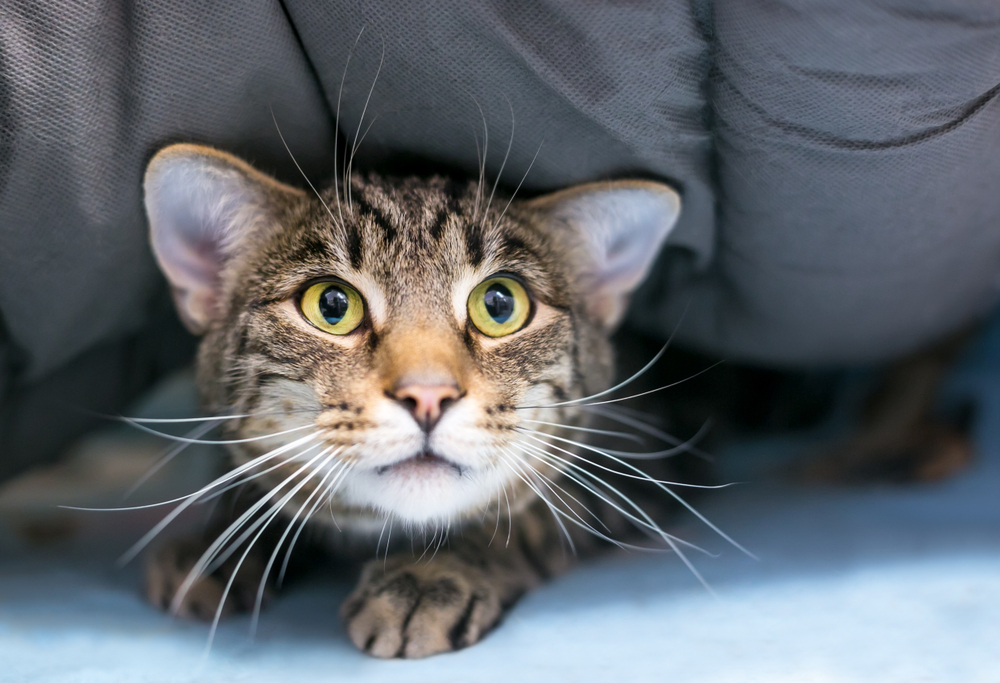If your pet overreacts to noises, they may have a noise aversion. The condition often goes undiagnosed and untreated in pets, negatively impacting their quality of life. Our Boca Midtowne Animal Hospital team wants to help alleviate your pet’s fear, and we explain things you should know about noise aversion.
#1: Pet noise aversion is a serious problem
A noise aversion is a fearful response to a noise, most commonly a loud sound that the pet can’t localize. Common noise aversion triggers include thunder, fireworks, construction noise, traffic sounds, fire detectors, sirens, crowds, vacuum cleaners, and kitchen appliances. Affected pets experience panic-attack-level fear and anxiety that can lead to significant consequences, including:
- Psychological trauma — Noise-averse pets are extremely scared and anxious, which can lead to significant psychological trauma.
- Physical injury — During a noise episode, affected pets often try to escape, which can lead to injuries, such as cuts from broken glass or being hit by a car.
- Health complications — Chronic stress caused by noise aversion can lead to health problems, such as dermatological issues, increased infection susceptibility, and urinary tract disorders.
- Behavioral problems — Many noise-averse pets exhibit behavioral problems, including inappropriate elimination and aggressive behavior.
- Other stress-related conditions — Noise-averse pets are at higher risk for other stress-related conditions (e.g., separation anxiety).
#2: Several factors can contribute to pet noise aversion
In many cases, the inciting cause of a pet’s noise aversion is unknown, but several factors can contribute to the condition, including:
- Genetics — Certain breeds, including herding and pointing breeds, seem predisposed.
- Improper socialization — Socialization refers to exposing a pet to numerous sights, sounds, and experiences when they are young to help them learn to adapt to new situations. Pets who aren’t properly socialized are at increased risk for developing a noise aversion.
- Upsetting incident — Some pets associate a noise with an upsetting incident and continue to fear the sound.
- Pain or illness — Pets who are sick or in pain may feel more vulnerable and react more strongly to noises.
- Cognitive dysfunction — Senior pets often experience cognitive decline as they age, and increased stress and anxiety are common signs.
#3: Pet noise aversion can be overlooked
Many owners don’t realize their pet is noise-averse. Signs can vary in severity and may include:
- Lip licking
- Excessive panting
- Lifting a front limb
- Whining
- Crouching
- Shivering
- Hiding
- Seeking attention
- Vocalizing (i.e., barking or meowing)
- Pacing
- Trying to escape
- Exhibiting aggression
- Urinating or defecating inappropriately
- Expressing the anal glands
#4: Environmental management can benefit your pet’s noise aversion
Environmental management can help address pet noise aversion. Techniques include:
- Creating a safe place — Create a comforting, safe space, such as a crate, closet, or windowless room. Ensure your pet has the necessary resources, including their favorite blanket or your recently worn clothing to help them feel secure. Feed them in this area so they make positive associations, and provide toys to help distract them from unpleasant situations.
- Masking the sound — Playing music or white noise or leaving the television playing can help mask upsetting noises.
- Distracting your pet — Playing with your pet or a food puzzle toy can help distract them from upsetting noises.
#5: Behavior modification can benefit your pet’s noise aversion
Behavior modification techniques can be used to desensitize and countercondition your pet, although this strategy typically takes several weeks or months to take effect. Steps include:
- Choosing a recording — Find a soundtrack (i.e., fireworks, thunderstorm) that triggers your pet’s fear response.
- Playing the recording quietly — Play the recording at a low enough volume that your pet remains calm.
- Counter-conditioning your pet — Play the recording for a 10- to 15-minute session while you feed your pet or play their favorite game
- Desensitizing your pet — At each session, gradually increase the volume to help desensitize your pet to the noise.
- Going slow — If your pet reacts fearfully or anxiously, reduce the volume until they calm down. End the session and begin incrementally increasing the volume at the next session.
- Testing the effects — Don’t assume your pet is cured because they remain calm when the recording plays at full volume. Monitor them closely when a real-life trigger occurs, to determine if they are still affected by an aversion.
#6: Calming devices can benefit your pet’s noise aversion
Some noise-averse pets benefit from calming wearable devices, such as:
- Close-fitting vests — A close-fitted vest reduces stress by calming the autonomic nervous system, which is responsible for the fight or flight response.
- Earphones — Noise canceling headphones can help muffle upsetting noises.
#7: Medications can benefit your pet’s noise aversion
In severe cases, your noise-averse pet may need pharmaceutical help. Options include calming supplements, sedatives, and anti-anxiety medications, which typically work best if administered before the triggering noise. Our team can help determine what product is most appropriate for your pet.
Check out Dr. Man’s video to see which product he uses on his own dog, Millie!
#8: The wrong response can exacerbate your pet’s noise aversion

Staying calm is the best response when your pet has a noise aversion episode. Contraindicated responses include:
- Scolding your pet — Scolding your pet can scare them and exacerbate the situation.
- Overreacting — Dramatically comforting your pet can worsen the situation by making them think they have good reason to be upset.
If your pet overreacts to a noise, contact our Boca Midtowne Animal Hospital team, so we can ensure a medical condition isn’t contributing to their problem. Then, we can determine how to alleviate their fear most effectively.







Leave A Comment